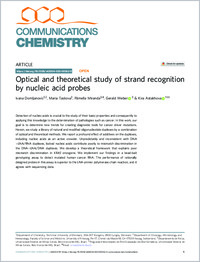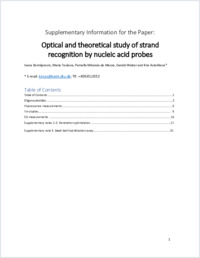Optical and theoretical study of strand recognition by nucleic acid probes
- Domljanovic, Ivana Department of Chemistry, Technical University of Denmark, 206-207 Kongens, 2800 Lyngby, Denmark - Department of Oncology, Microbiology and Immunology, Faculty of Science and Medicine, University of Fribourg, Per 17, Chemin du Musée 18, CH-1700 Fribourg, Switzerland
- Taskova, Maria Department of Chemistry, Technical University of Denmark, 206-207 Kongens, 2800 Lyngby, Denmark
- Miranda, Pâmella Departamento de Física, Universidade Federal de Minas Gerais, Belo Horizonte-MG, Brazil. 4 Programa Interunidades de Pós-Graduação em Bioinformática, Universidade Federal de Minas Gerais, Belo Horizonte-MG, Brazil -
- Weber, Gerald Departamento de Física, Universidade Federal de Minas Gerais, Belo Horizonte-MG, Brazil. 4 Programa Interunidades de Pós-Graduação em Bioinformática, Universidade Federal de Minas Gerais, Belo Horizonte-MG, Brazil
- Astakhova, Kira Department of Chemistry, Technical University of Denmark, 206-207 Kongens, 2800 Lyngby, Denmark
-
2020
Published in:
- Communications Chemistry. - 2020, vol. 3, no. 1, p. 111
English
Detection of nucleic acids is crucial to the study of their basic properties and consequently to applying this knowledge to the determination of pathologies such as cancer. In this work, our goal is to determine new trends for creating diagnostic tools for cancer driver mutations. Herein, we study a library of natural and modified oligonucleotide duplexes by a combination of optical and theoretical methods. We report a profound effect of additives on the duplexes, including nucleic acids as an active crowder. Unpredictably and inconsistent with DNA+LNA/RNA duplexes, locked nucleic acids contribute poorly to mismatch discrimination in the DNA+LNA/DNA duplexes. We develop a theoretical framework that explains poor mismatch discrimination in KRAS oncogene. We implement our findings in a bead-bait genotyping assay to detect mutated human cancer RNA. The performance of rationally designed probes in this assay is superior to the LNA-primer polymerase chain reaction, and it agrees with sequencing data.
- Faculty
- Faculté des sciences et de médecine
- Department
- Médecine 3ème année
- Language
-
- English
- Classification
- Biological sciences
- License
-
License undefined
- Identifiers
-
- RERO DOC 329488
- DOI 10.1038/s42004-020-00362-5
- Persistent URL
- https://folia.unifr.ch/unifr/documents/308975
Other files
Statistics
Document views: 99
File downloads:
- pdf: 155
- Supplementary material: 133
- Supplementary material 2: 113


